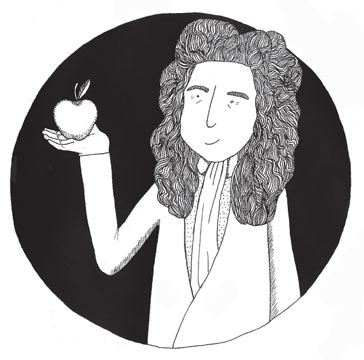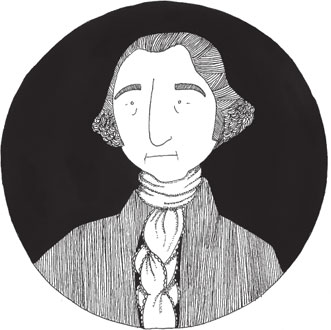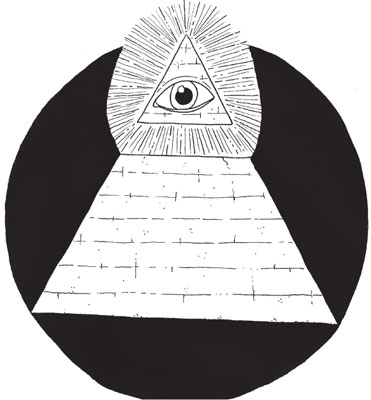The Little Book of the End of the World (16 page)
Read The Little Book of the End of the World Online
Authors: Ken Mooney

Despite his seeming lack of interest in religious life, Newton committed himself to the study of the Bible. He had an interesting theory about its contents and the writings of classical philosophers and scientists: he believed that the Bible contained great truths and enlightenment but these messages had been lost in time. After centuries of subsequent translations, each of which would have been subtly influenced by the intentions of the translators, this enlightenment was no longer visible in the contemporary Bible.
With no small amount of pride, Newton considered himself to be divinely inspired to understand the messages within the Bible’s pages and that only he and a few select others could lift the veil of ignorance that hung over its contents. Newton’s work in this field appears to have been motivated by pride rather than any concern about the End of Days; in fact, Newton even acknowledged that if and when he was able to completely understand the Bible, its contents may not be truly and completely understood until after any prophesied events had taken place.
Using knowledge of classical numerology and architecture, Newton developed an interpretation of the dates and years within the Bible where each ‘day’ corresponded to a year, all the while paying specific attention to the calendars used by those who wrote and compiled the Bible. While Newton disagreed with the practice of specifying dates for the Apocalypse, he instead pointed towards a range of dates, suggesting that the End of Days described in the Bible would not occur any earlier than 2060, nor any later than 2370.
However, Newton never made these speculations public, and they come to us through scrawled notes discovered in the early twenty-first century and attributed to Newton. While the notes outline Newton’s method at arriving at these dates, there is no corroborating evidence that these were meant to be anything other than theories or partial deductions that would have formed a part of a bigger picture.
Like Leonardo da Vinci, the stories that grew around Newton’s diverse interests have been manipulated through time, and popular culture and conspiracy theories also associate Newton with secret orders and societies.
Chief amongst these societies was the Rosicrucians, a network of scientists and philosophers who, like Newton, looked to classical texts and their writers as possessors of mystical knowledge. With a name derived from the imagery of a red – or bloody – cross, the Rosicrucians believed that, by combining religious imagery with the classical sciences, they could achieve enlightenment.
There is no evidence that Newton was a member of this order, nor that the order truly existed, but the story of its creation has spawned many other tales, and even more imitators.

14
The late eighteenth century triggered a period of political instability across the world, due in no small part to the scientific and philosophical learning of the Age of Enlightenment. This knowledge had a direct effect on political thoughts and theories, lending confidence and authority to elements of society that had previously been oppressed.

GEORGE WASHINGTON AND THE AMERICAN REVOLUTION
After years of British rule, the seeds of nationalism and independence began to grow in America in the mid-eighteenth century. At the forefront of the American movement for independence was George Washington, a man whom popular culture has tied to as many secret societies as Newton and Leonardo da Vinci.
Washington was definitely a man of Christian faith, but his religious affiliations are still speculated about: during his life, Washington attended services and sermons at many different churches of many different denominations. But one thing is common: Washington did not take communion at any of them.
However, the associations between Washington and secret societies are not as spurious as with Newton or da Vinci: Washington was initiated into the Freemasons in 1752 and was appointed Master of the Virginia Lodge in 1788.
FREEMASONS: A SOCIETY WITH SECRETS
Freemasonry has its origins in the fourteenth century. There is no definitive written history of public record, but it is believed to have the same origins as European trade guilds. These guilds were initially groups of craftsmen providing mutual training and support, as well as confirming a certain standard of their work.
Local organisations of Freemasons are known as Lodges, with mutual membership and recognition of others. In an age before social media, travelling Freemasons could be welcomed at the local Lodge and expect to find acquaintances and lodgings there.
The Freemasons are also heavily involved in local community and charity. Although they maintain a public front, the organisation itself remains impenetrable to the common man, and as befits any such organisation, an air of mystery has grown around the Freemasons and their members.
The Freemasons themselves are not a hidden society: the location of Lodges is openly known – especially those of grand design – and much of their imagery and symbolism is transparent, including a great emphasis on religious, mathematical and architectural symbolism.
Freemasons are quick to suggest that they are not a secret society, but rather that there are elements of the society that they choose to keep private from non-members. As a result, stories and legends have developed around the idea of Freemasonry. Some of this has taken the form of anti-Masonic propaganda, suggesting that the Freemasons are involved in secret plots to rule the world.
The Anti-Masonic Party was formed in America in 1828 as a political movement firmly opposed to the spread of Freemasonry and its teaching. Although the party only existed for a decade, it raised enough questions about the Freemasons, their secret beliefs and their methodologies that a stigma has been associated with their name ever since.
Freemason Albert Pike, a well-known American confederate and attorney, highlighted the links between Freemasonry and ancient mysteries; while this could be seen as merely boastful, or even an attempt to explain Freemasonry without disclosing its secrets, this was taken by the Anti-Masonic Party and other rivals as an indication that the society was allied with pagan or Satanic worship. In actual fact, the ancient mysteries discussed by Pike are probably the same mathematical and universal orders embraced by Newton.
As with any society operating in secret, conspiracy theories have suggested that the Freemasons are the public face of the Illuminati and are pivotal players in global politics. In truth, Freemasonry is not a religion, and there are no public writings or theories on the End of the World. The society has members from all religions and ethnic denominations, placing great importance on an individual’s faith and the honour and truth descending from that.
THE ILLUMINATI AND THE NEW WORLD ORDER
Most of the conspiracy theories relating to secret societies have a common root: they are linked to the concept of the Illuminati, a secret society in their own right who use Freemasons, Rosicrucians and other orders as a front to their far more sinister and dastardly organisation. There is no proof that the Illuminati exist, but like other orders, they have their origins in very real history.
The historical Illuminati were founded by Adam Weishaupt in 1776 at the University of Ingolstadt in Bavaria. The society was modelled on the structure of the Freemasons, with the aim of promoting education and liberal thinking, eliminating superstition and doing away with the tight religious hold over politics and education.
Because of its radical ideas, the group operated in a sort of secret capacity, constantly under the threat of being condemned for heresy or treason. This organisation was outlawed and disbanded by royal decree in 1777, though two different books published only decades later claimed that the society was still functioning and had been largely responsible for the events behind the French Revolution.
This rumour was quite popular at the start of the nineteenth century, with further myths and legends suggesting that the Illuminati were also involved in the American Revolution, the Great Fire of London and other large-scale political events or disasters. Even as rational men spoke out about the unlikelihood that such an organisation could exist, these statements created a self-perpetuating cycle, taken as being nothing more than the society’s attempts to cover its own tracks.
These theories and conspiracies have continued into the twenty-first century, with suggestions that the Illuminati continue to exert great power over international governments, even possessing advanced technology that allow them to trigger earthquakes or tornadoes. In this age of mass media, any event that is not wholly understood can be blamed on this secret society and its mysterious ways.
Believers suggest that the Illuminati are manipulating events as they work towards the creation of a New World Order, a unified worldwide government; if the Endtimes of Revelations involve all of humanity uniting under one leader, any movement towards a worldwide government appears to be hastening that Armageddon. This theory is by no means the largest resistance to the United Nations and the European Union, but it should not be forgotten when patriots argue for sovereign rule.
The phrase ‘new world order’ was first coined in the wake of the First World War, and was a legitimate reference to the existence of the League Of Nations: the League had been formed in the wake of global warfare, recognising the growing need for international politics to look at a bigger, worldwide picture. While the League of Nations was never meant to lead to a new world government, some of its opponents still resisted the power that any organisation like this would have over member nations.
The phrase ‘new world order’ was used by US President Woodrow Wilson and by Winston Churchill, seeping into popular consciousness. Later, the phrase was used by H.G. Wellls as the title for his book
The New World Order.
In this book, Wells outlined his theories for a government that could span the entire world: it is a non-fictional discussion of how this government could work, similar to Plato’s
Republic
or Moore’s
Utopia.
In the years since publication, it’s been suggested that this book was written after Wells uncovered some secret truths behind the Illuminati and the New World Order; of course, he is not the only science-fiction writer of the twentieth century whose ideas have been taken as gospel truth.

One of the key parts of Wells’ imagined future is the increasingly large role of corporations and industry: as bigger multinational companies operate on a global basis, various parties look towards their influence on all types of government as a negative factor.
The conspiracies involving the Illuminati are so varied that they would require their own book to discuss fully. But if you fear for the coming Apocalypse and are looking for a group to blame, open season has been declared on the Illuminati for centuries.
THE FRENCH REVOLUTION: A CASE STUDY IN DYSTOPIA
The year 1789 saw the first rumblings of the French Revolution, one of the definitive movements that signalled the end of an age of empires and monarchy. Unfortunately, as empires died, new movements grew that would seek to take their place.
